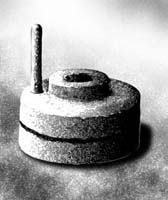
A grinding stone - a common household item in rural India - is kept in the north corner of the western wall. Baba apparently had two or three such stones (another is on display in the Samadhi Mandir) which, on occasion, he used for grinding wheat. The most famous of these became the inspiration for Hemadpant's celebrated Sri Sai Satcharitra. It is described as follows:
One morning, some time after the year 1910, while I was in Shirdi, I went to see Sai Baba at his mosque. I was surprised to find him making preparations for grinding an extraordinary quantity of wheat. After arranging a gunny sack on the floor, he placed a hand-operated flour mill on it and, rolling up the sleeves of his robe, he started grinding the wheat. I wondered at this, as I knew that Baba owned nothing, stored nothing and lived on alms. Others who had come to see him wondered about this too, but nobody had the temerity to ask any questions.
As the news spread through the village, more and more men and women collected at the mosque to find out what was going on. Four of the women in the watching crowd forced their way through and, pushing Baba aside, grabbed the handle of the flour mill. Baba was enraged by such officiousness, but as the women raised their voices in devotional songs, their love and regard for him became so evident that Baba forgot his anger and smiled.
As the women worked, they too wondered what Baba intended doing with such an enormous quantity of flour...They concluded that Baba, being the kind of man he was, would probably distribute the flour between the four of them...When their work was done, they divided the flour into four portions, and each of them started to take away what she considered her share.
"Ladies, have you gone mad!" Baba shouted. "Whose property are you looting? Your father's? Have I borrowed any wheat from you? What gives you the right to take this flour away?"
"Now listen to me," he continued in a calmer tone, as the women stood dumbfounded before him. "Take this flour and sprinkle it along the village boundaries."


